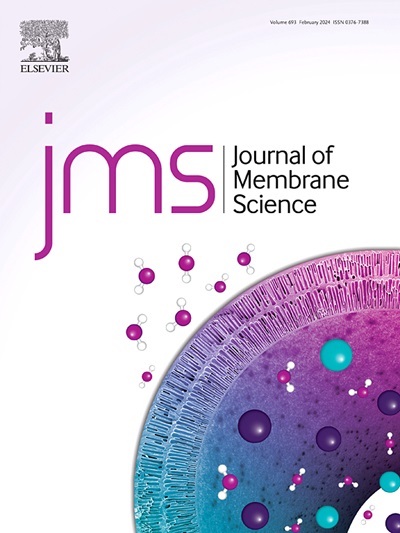基于可编程己内酰胺调制的聚酰胺分子设计驱动亚纳米空腔工程用于高性能SWRO膜
IF 8.4
1区 工程技术
Q1 ENGINEERING, CHEMICAL
引用次数: 0
摘要
日益增长的全球淡水需求推动了对具有增强淡化性能的高通量海水反渗透(SWRO)膜的需求。SWRO膜的芳香族聚酰胺(APA)层是一种具有网络结构的二维纳米膜,通过间苯二胺(MPD)和三甲基氯(TMC)缩合形成,然后经过交联、折叠和压实等过程。因此,精确调节APA层中苯环间距,优化自由体积的大小和分布,有望显著提高渗透通量,同时保持超高截留率。本研究在界面聚合过程中引入己内酰胺(CPL),采用“链连接-分子分离-造腔”策略。CPL分子通过位阻效应与酰基氯发生反应,削弱了氢键和π-π相互作用,实现了苯环间距的亚埃级扩张,从而修饰了APA网络。随后水诱导CPL脱离APA基质,产生亲水性羧基,同时留下分子尺度的空腔。这一过程同时增加了APA的自由体积尺寸和数量,同时缩小了APA的孔径分布。优化后的SWRO膜水通量为59.85 L m−2 h−1,NaCl去除率为99.70%。本研究为通过分子水平的结构工程设计高效、低能的SWRO膜提供了一种新的途径。本文章由计算机程序翻译,如有差异,请以英文原文为准。
Molecular design-driven sub-nanometer cavity engineering in polyamide via programmable caprolactam modulation for high-performance SWRO membranes
The growing global freshwater demand drives the need for high-flux seawater reverse osmosis (SWRO) membranes with enhanced desalination performance. The aromatic polyamide (APA) layer of SWRO membranes is a two-dimensional nanofilm with a networked structure, formed through m-phenylenediamine (MPD) and trimesoyl chloride (TMC) condensation, followed by cross-linking, folding, and compaction processes. Therefore, precise regulation of the benzene ring spacing in APA layer, along with optimization of the size and distribution of free volume, holds great promise for significantly enhancing permeation flux while maintaining ultra-high rejection. This study employed a “chain linking - molecular detachment - cavity construction” strategy by introducing caprolactam (CPL) during interfacial polymerization. The CPL molecules reacted with acyl chloride groups and weakened hydrogen bonding and π-π interactions through steric hindrance effects, achieving sub-angstrom-level expansion of benzene ring spacing, thereby modifying the APA network. Subsequent water-induced CPL detachment from the APA matrix generated hydrophilic carboxylic groups while leaving molecular-scale cavities. This process simultaneously increased free volume dimensions and quantity while narrowing pore size distribution of APA. The optimized SWRO membranes achieved distinguished 59.85 L m−2 h−1 water flux with 99.70 % NaCl rejection. This work provides a novel approach for designing high-efficiency, low-energy SWRO membranes through molecular-level structural engineering.
求助全文
通过发布文献求助,成功后即可免费获取论文全文。
去求助
来源期刊

Journal of Membrane Science
工程技术-高分子科学
CiteScore
17.10
自引率
17.90%
发文量
1031
审稿时长
2.5 months
期刊介绍:
The Journal of Membrane Science is a publication that focuses on membrane systems and is aimed at academic and industrial chemists, chemical engineers, materials scientists, and membranologists. It publishes original research and reviews on various aspects of membrane transport, membrane formation/structure, fouling, module/process design, and processes/applications. The journal primarily focuses on the structure, function, and performance of non-biological membranes but also includes papers that relate to biological membranes. The Journal of Membrane Science publishes Full Text Papers, State-of-the-Art Reviews, Letters to the Editor, and Perspectives.
 求助内容:
求助内容: 应助结果提醒方式:
应助结果提醒方式:


